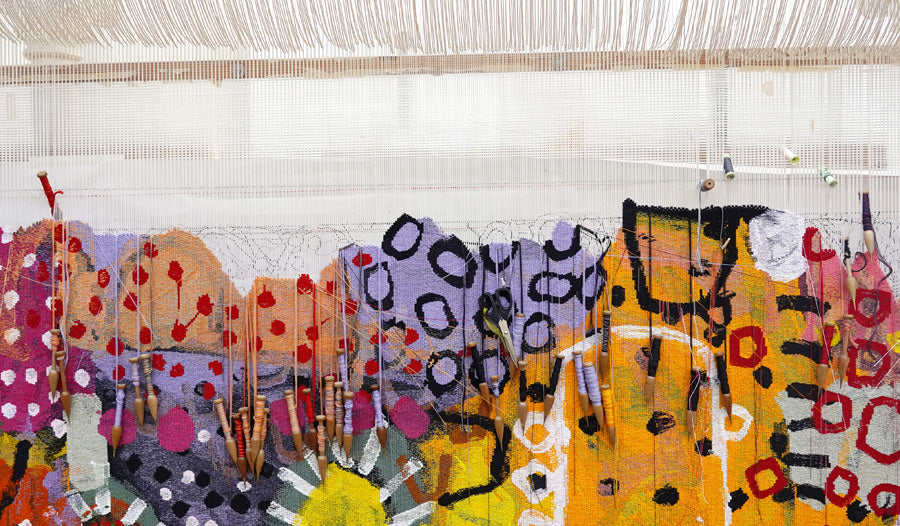
A Golden Harvest

Established in 1976, the Australian Tapestry Workshop (ATW) is the only national organisation of its kind dedicated to creating contemporary tapestries. Founded on the philosophy of shared creative endeavour, the Workshop's specialist weavers and master dyer collaborate with leading artists, architects, and designers. Employing the Gobelin technique, the ATW has a base range of over 368 coloured yarns all specially formulated and dyed on-site in the Colour Laboratory. All tapestries are made from high-quality Australian wool, grown using environmentally sustainable and humane animal practices.
Since 2004, the ATW has produced the so-called 'Embassy Tapestries' that celebrate Indigenous artists and recognise their unique connection with, and custodianship of, the Australian landscape. These distinctive works have graced the Australian embassies in Tokyo, Beijing, Washington DC, Paris, Dublin and Rome, and the High Commissions in New Delhi and Singapore. Naomi Hobson's The Royal Harvest (2021) is the tenth of this series, destined for the Embassy in Jakarta when the easing of travel restrictions permits its installation.

Hobson is a Kaantju/Umpila artist who hails from the small township of Coen on the Cape York Peninsula in far north Queensland. With a population of less than 400 residents, Coen is situated at the bottom of the McIlwraith Ranges, part of the Great Dividing Range. Gold prospecting in the late 1870s, pastoral leases, and the overland telegraph line that came to the region in the 1880s made Coen an important regional supply point. Hobson's grandfather worked as a stockman for European settlers but received no payment–an entrenched and accepted exploitation at the time. Her family has been prominent within the Indigenous land rights movement and efforts to introduce social and economic reforms within the wider Cape York community.
For Hobson, devotion to the lands on which her forebears dwelt for millennia is communicated within a practice that encompasses painting, photography, and ceramics. ‘If anyone were to travel to my country they would be overwhelmed by the biodiversity of life and of landscapes. And within all the beauty of the natural systems is a living cultural landscape that my ancestors formed, nurtured, and thrived in for thousands of generations; we are as much a part of these systems as anything else’, she contends. ‘I can never let go of this. I am at all times appreciative of the knowledge, wisdom, and humility of my old people... I am grateful that my grandparents, who were born and raised on their traditional lands, were alive to pass on their immense cultural knowledge.’

The Royal Harvest emphasises the strong and enduring reciprocity between Indigenous groups in Northern Australia and the Maccassans of the Indonesian archipelago. ‘I have always felt comfortable when visiting South East Asia. I see elements of my culture in the people there. I feel they have extremely strong kinship structures just as we do. Family appears to be everything, and the respect between people, respect for country, and cultural beliefs to me feels [that] we have so much in common’, she observes. ‘There remains a continuity between the cultures, even if it is not widely understood in today's world.’
Teeming with colour and complexity, Hobson's painting represents bounty, vitality, and the type of unfettered access to regional neighbours the pandemic all but extinguished. ‘The shapes suggest trading movement through country and the colours are capturing the energy, joy, abundance and excitement of trading between the two cultures. I am expressing vibrant relationships that have blossomed and enriched the village life of today with exotic flavours, and the diversity of our language and skills.’
Extract from the article Golden Thread: Naomi Hobson at the Australian Tapestry Workshop, written by Inga Walton in Issue 101 Grow.
